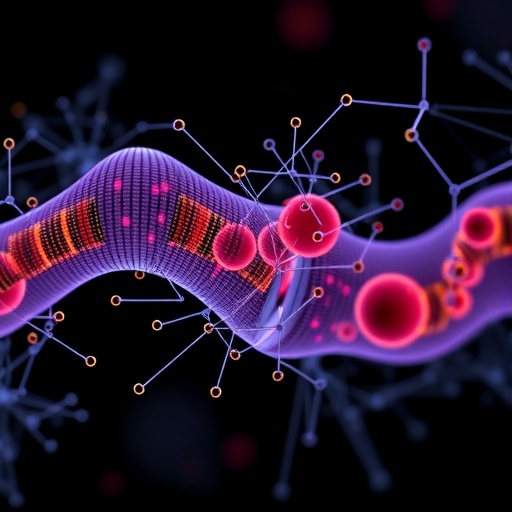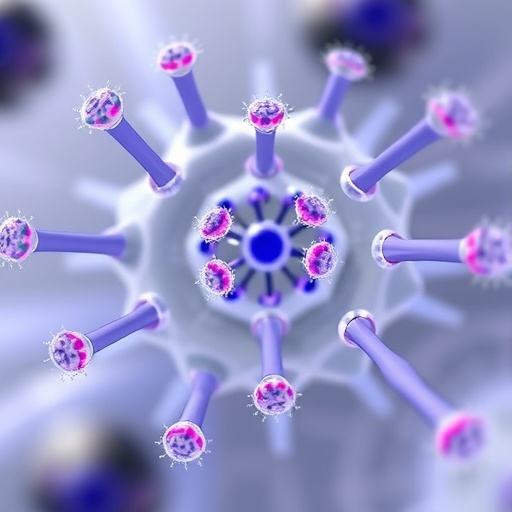
In recent years, the therapeutic landscape of melanoma has undergone a profound transformation, driven by advances in understanding the metabolic dynamics within the tumor microenvironment and their impact on immune evasion. Immunotherapy, heralded for its revolutionary potential in treating various cancers, encounters significant obstacles in melanoma due to the complex interplay between tumor metabolism and immune suppression. Researchers are now delving deeper into how alterations in tumor and immune cell metabolism dictate the effectiveness of these immunotherapeutic strategies, offering promising avenues to enhance response rates and overcome resistance.
A hallmark metabolic phenomenon in melanoma is the Warburg effect, characterized by the tumor’s preference for glycolysis over oxidative phosphorylation, even in oxygen-rich conditions. This metabolic shift culminates in an acidic tumor microenvironment, principally through the accumulation and export of lactic acid. Such acidification imposes a potent inhibitory effect on key immune effector cells, including natural killer (NK) cells, dendritic cells (DCs), and cytotoxic CD8+ T lymphocytes. These immune cells, crucial for mounting an effective antitumor response, become functionally impaired in this hostile milieu, facilitating tumor immune escape and supporting melanoma progression.
Neutralizing the acidic conditions within the tumor microenvironment has shown significant promise in preclinical models. For instance, bicarbonate monotherapy, by buffering the pH of the tumor surroundings, dramatically limits tumor growth and amplifies the tumor’s susceptibility to immunotherapy. Similarly, targeting glycolytic pathways within melanoma cells suppresses lactic acid production, alleviating the immunosuppressive barrier and allowing enhanced infiltration of cytotoxic lymphocytes. This metabolic intervention reinvigorates antitumor immunity and raises the prospect of combining metabolic modulators with established immune checkpoint inhibitors for synergistic effects.
.adsslot_BISlTgaijq{width:728px !important;height:90px !important;}
@media(max-width:1199px){ .adsslot_BISlTgaijq{width:468px !important;height:60px !important;}
}
@media(max-width:767px){ .adsslot_BISlTgaijq{width:320px !important;height:50px !important;}
}
ADVERTISEMENT
Nanoscale technologies are emerging as innovative tools to manipulate tumor metabolism selectively. A prime example is the tumor-targeted peroxynitrite nanogenerator (APAP-P-NO), engineered to disrupt the metabolic equilibrium within melanoma cells while sparing immune cells. By inducing targeted metabolic stress, APAP-P-NO reshapes the immunosuppressive microenvironment, restoring immune surveillance and facilitating tumor destruction. Such sophisticated approaches herald a new era in precision immunometabolism, integrating metabolic reprogramming with immune modulation.
Beyond the microenvironmental pH, specific metabolites within melanoma cells themselves have been implicated in immune evasion and therapy resistance. Acetyl-CoA, a central metabolite linking metabolism to epigenetic regulation, has been identified as a driver of PD-L1 expression through p300-mediated histone acetylation. This modification enhances the transcription of the CD274 gene, encoding PD-L1, a key immune checkpoint ligand that shields tumor cells from T cell-mediated killing. Targeting the nucleo-cytosolic pools of acetyl-CoA reduces PD-L1 expression, promoting increased T cell infiltration and boosting the effectiveness of immunotherapy. Such insights illuminate the intricate connections between cellular metabolism, epigenetic regulation, and immune checkpoint pathways in melanoma.
In parallel, inosine, a purine metabolite, plays a compelling role in modulating tumor immunogenicity. Elevated inosine levels inhibit the activity of ubiquitin-like modifier activating enzyme 6 (UBA6), leading to increased tumor sensitivity to immune checkpoint blockade. In preclinical melanoma models, inosine administration alongside anti-CTLA4 and anti-PD1 antibodies significantly curbs tumor growth, highlighting the potential of metabolic adjuvants to enhance immunotherapeutic outcomes. These findings underscore metabolite-mediated regulatory networks as fertile ground for novel combination strategies in melanoma treatment.
The metabolic constraints imposed by the tumor microenvironment extend to tumor-infiltrating lymphocytes (TILs) themselves. Survival and effector function of CD8+ TILs hinge on their ability to reprogram metabolism and sustain energy production under nutrient-deprived, immunosuppressive conditions. Studies have revealed that activation of Peroxisome proliferator-activated receptor alpha (PPAR-α) signaling and enhanced fatty acid oxidation (FAO) are vital for the persistence and antitumor activity of these lymphocytes. This metabolic flexibility allows TILs to endure and proliferate within the challenging tumor niche, providing a rationale for therapeutic strategies aimed at boosting FAO pathways to empower immune responses.
Moreover, the metabolite phosphoenolpyruvate (PEP) has emerged as an important modulator of T cell signaling and function. PEP sustains Ca2+-dependent nuclear factor of activated T cells (NFAT) signaling by repressing sarco/endoplasmic reticulum Ca2+-ATPase (SERCA), thus maintaining T cell receptor (TCR) activation and effector cytokine production. Overexpressing the gluconeogenic enzyme PCK1 increases PEP production in T cells, enhancing their antitumor capacity. Experimental models demonstrate that adoptive transfer of PCK1-overexpressing T cells results in significant tumor growth limitation and extended survival, highlighting metabolic engineering of immune cells as an innovative therapeutic frontier.
Mitochondrial biogenesis and enhanced oxidative phosphorylation (OXPHOS) also characterize the metabolic profile essential for effective TIL function. The transcriptional coactivator PGC1α orchestrates mitochondrial quality and quantity, promoting sustained energy metabolism and resistance to tumor-induced metabolic stress. Enforced expression of PGC1α in CD8+ T cells has been shown to amplify antitumor immunity in melanoma models, offering a potential avenue to improve outcomes in adoptive cell therapies. Likewise, metabolic reprogramming mediated by transcription factors such as FOXP3 can modulate CD8+ T cell metabolism, further impacting their therapeutic efficacy.
Dendritic cells (DCs) are pivotal orchestrators of antitumor immunity, yet tumor-derived factors often hijack their metabolism and function. Immunosuppressive molecules and tumor-associated glycans released within the microenvironment alter DC metabolic pathways, undermining their capacity to prime and activate effective T cell responses. One therapeutic strategy involves inhibiting monocarboxylate transporter 1 (MCT1) using agents like BAY8002, which prevents glycolytic skewing of DCs induced by tumor-derived glycans. Restoring DC metabolic balance reinvigorates their immunostimulatory function and supports robust antitumor T cell activity.
Resistance to immune checkpoint inhibitors, notably anti-PD1 therapy, is frequently associated with altered DC metabolism. In resistant tumors, DCs show enhanced mitochondrial respiration and fatty acid oxidation yet exhibit diminished T cell stimulatory capacity. Targeting MerTK, a receptor tyrosine kinase implicated in immunosuppression, modulates DC metabolic checkpoints and rescues their functionality, thereby improving responses to PD1 blockade. This paradigm exemplifies how fine-tuning immune cell metabolism can overcome therapeutic resistance and unlock durable antitumor immunity.
The convergence of metabolic and immunologic research in melanoma unveils a sophisticated network of interactions dictating therapy response. By dissecting the metabolic vulnerabilities of both tumor cells and immune effectors, researchers envision integrative therapeutic regimens combining metabolic modulators with checkpoint inhibitors and adoptive cell therapies. Such multimodal strategies aim to remodel the tumor microenvironment, incapacitate tumor immune escape mechanisms, and invigorate potent, sustained immune surveillance.
As technological leaps in metabolomics, epigenetics, and nanotechnology expand the toolkit for interrogating tumor-immune crosstalk, unprecedented opportunities arise to personalize melanoma therapy. Investigating metabolite-specific immune checkpoints and engineering metabolic pathways in immune cells herald an exciting chapter in cancer immunotherapy. The promise of these innovations lies in their potential to convert immunologically “cold” tumors into “hot” ones, dramatically increasing clinical response rates and prolonging patient survival.
In summary, understanding and manipulating the metabolite-mediated immune evasion in melanoma represents a cutting-edge frontier in cancer treatment. The acidic tumor environment, influenced by glycolysis-induced lactic acid, impairs immune cell function, yet can be counteracted by metabolic interventions. Key metabolites such as acetyl-CoA and inosine regulate immune checkpoints and tumor immunogenicity through epigenetic and enzymatic pathways. Meanwhile, empowering TILs and DCs through metabolic reprogramming enhances their survival and function within the tumor niche, overcoming immune suppression and resistance. With ongoing multidisciplinary efforts, these metabolic insights are rapidly translating into sophisticated, effective therapies, offering renewed hope against this formidable malignancy.
Subject of Research: Metabolic reprogramming in melanoma and its impact on immune evasion and immunotherapy response.
Article Title: Metabolic reprogramming in melanoma therapy.
Article References:
Shen, D., Zhang, L., Li, S. et al. Metabolic reprogramming in melanoma therapy.
Cell Death Discov. 11, 308 (2025). https://doi.org/10.1038/s41420-025-02617-3
Image Credits: AI Generated
DOI: https://doi.org/10.1038/s41420-025-02617-3
Tags: acidic tumor microenvironment and immune suppressionbicarbonate therapy for cancerdendritic cells and tumor immunityenhancing immune response in cancerimmune evasion in cancer therapyimmunotherapy resistance in melanomametabolic dynamics of melanoma cellsmetabolic reprogramming in melanomanatural killer cells in melanoma treatmentnovel strategies in melanoma therapytumor microenvironment and cancer progressionWarburg effect in tumor metabolism





